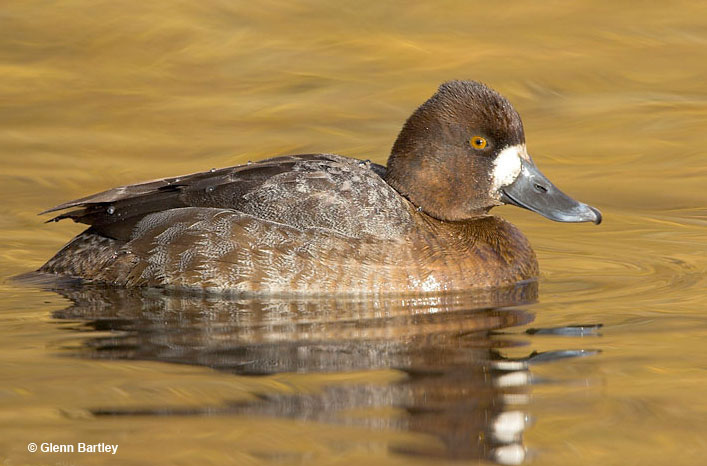Lesser Scaup (Aythya affinis) is a smart looking, pale gray and black duck with a gray bill. It can also be dark brown with white near the base of its beak.
Groups of dark brown and black and white ducks diving in large bodies of water could be this species. Flocks can also show up on smaller lakes in parks, but they prefer larger bodies of water.
Have you seen a Lesser Scaup? See this article to learn how to look for and identify this handsome duck!
On this page
Identification
The male Lesser Scaup has a black head, blue-gray beak with a small, narrow black tip, and a deep black chest. Its belly and flanks are white, and it has a pale gray, finely patterned back.
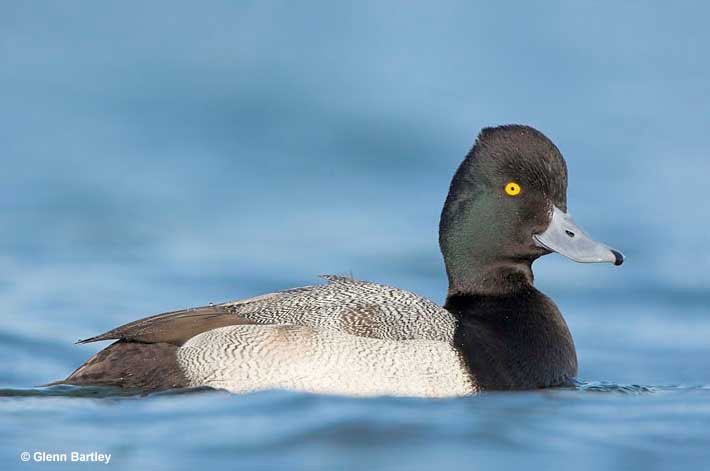
In good light, this bird’s head shows green or purple highlights, and, instead of being rounded, the back part of its crown is slightly peaked. This duck’s rump, tail, and undertail are jet black.
Female Lesser Scaups look very different. They are dark gray-brown with paler brown colors on their back and flanks, have a white belly, and a white patch on the front part of their face. Male Lesser Scaups in non-breeding plumage resemble females but have a darker head and breast, and very little white on their face.
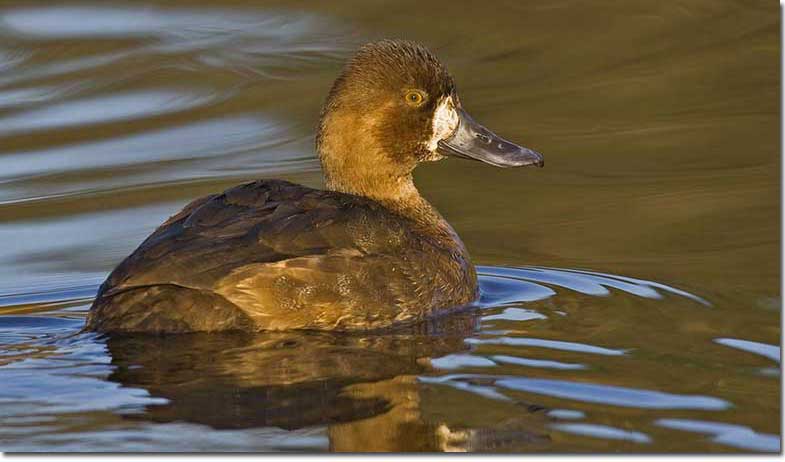
Female Lesser Scaup
They also have bright yellow eyes, are 16.5 inches long, have a 25 inch wingspan, and weigh 1.8 pounds.
In flight, all Lesser Scaups have white underwings, and a broad white stripe on half of the flight feathers of their upperwing. These ducks usually occur in flocks that float on the water but also have fast and direct flight.
Lesser Scaups don’t vocalize that often but can make clucking and bubbling calls during courtship.
Food
Lesser Scaups eat a variety of aquatic insects, mollusks, and crustaceans. In some places and times of year, they also feed on seeds and other plant matter but small aquatic creatures always form the most important part of their diet.
These ducks can take small bugs on top of the water but they do most of their foraging below the surface.
In summer, they dive in shallow wetlands and lakes to pick crustaceans and other small animals from underwater vegetation and the bottom.
They can catch those small creatures by sight but also find prey by touch. To accomplish this, the Lesser Scaup sticks its beak into silt underwater and moves it back and forth to find food while filtering out water and mud.
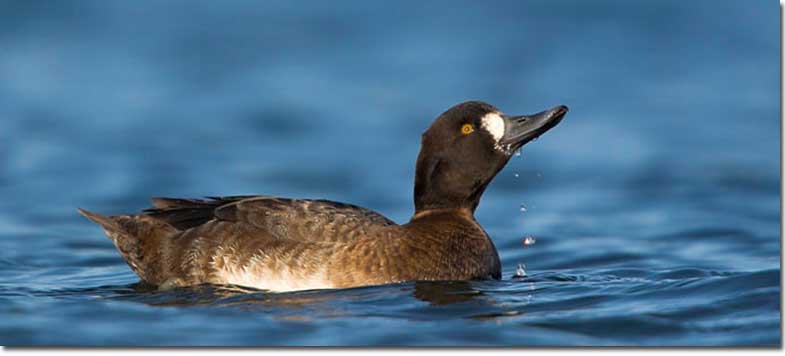
When it finds food underwater, the duck eats most of it right away but if it catches a crayfish or other big prey item, the bird takes it to the surface to eat. Sometimes, they also preen their feathers to catch and eat amphipods that attach to the duck!
In migration and winter, Lesser Scaups feed in the same way but don’t eat as many surface insects. Most dive for food in the waters of bays and lakes that are less than 20 feet deep.
Nesting and Eggs
Lesser Scaups form pairs in spring and start picking nest sites around four weeks after arriving on their breeding grounds. To pick a site, the hen duck flies around to look for a spot with grassy and weedy vegetation around a foot to two feet in height, especially on an island.
As long as the site has enough tall vegetation to hide the nest, this species can also use prairies, marshes, fields, and even floating vegetation. After picking a good spot, the female Lesser Scaup makes a small depression on the ground and starts to lay her eggs.
During egg laying, she adds feathers, grasses, and other vegetation to give the nest some structure and makes sure it is somewhat concealed from above.
She lays 6 to 14 plain, olive-brown eggs that are 2.2 inches long and weigh 1.7 ounces each. The mother duck incubates them for 21 to 27 days, and after they hatch, the ducklings leave the nest within 24 hours.
They stay with their mother for the next two to five weeks but catch food on their own. During this time, the female duck tries to protect them by driving away coots and gulls, and distracting predators by pretending to be injured.
Current Situation
The Lesser Scaup breeds in shallow wetlands and lakes in boreal and montane forests in Alaska, western and central Canada, and parts of the western USA. Large numbers winter on shallow wetlands, reservoirs, big lakes, and calm coastal waters from Vancouver and New York south to Central America.
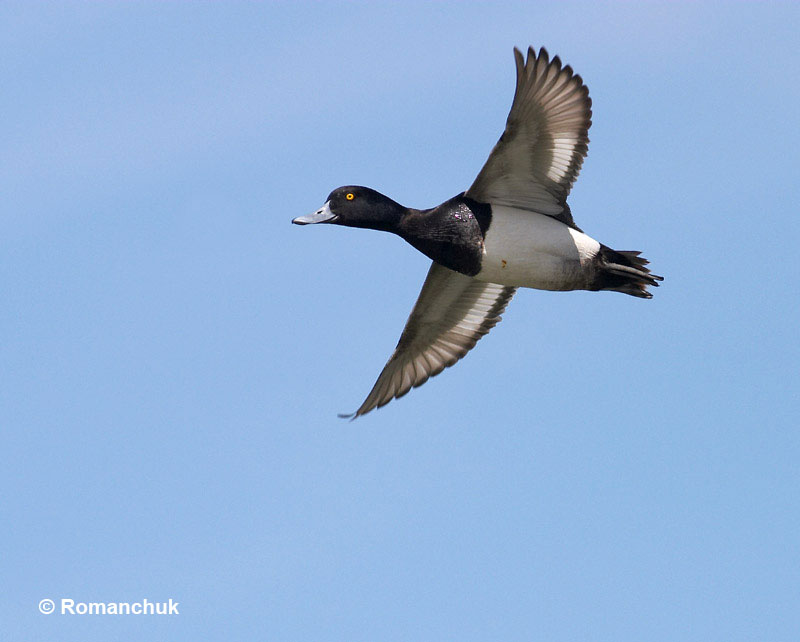
They are listed as Least Concern in the IUCN Red List and are common birds in most of their range.
The Lesser Scaup is the most common “diving duck” species. It has an estimated population of five and a half million, is fairly common, and is not considered to be threatened. Even so, biologists believe its population is much lower than in the past and should be higher.
Challenges to increasing the numbers of Lesser Scaup are mostly related to habitat degradation both on their breeding grounds and wintering areas.
This species is affected by draining of wetlands, reduction in water quality that reduces mollusks and other prey they feed on, and by oil spills and pollution.
Some birds also die in fishing nets, from collisions with illuminated towers, and other factors. Although Lesser Scaups are still common birds, this could change with continued habitat destruction.
Facts
- The Lesser Scaup is one of the last ducks to arrive on its breeding grounds. This is probably related to the shallow water habitats it uses for feeding and nesting, and might also be related to this duck wintering further south than other duck species. Some migrate all the way to South America for the winter!
- This species is very much at home on top of and under the water. At just 5 to 7 weeks of age, ducklings can stay underwater for 25 seconds and swim for 60 feet.
- The Lesser Scaup and other scaup species are named after their favorite food. “Scaup” is believed to be a derivation of an old word for “shellfish”, small animals that play important roles in the diets of these and other diving ducks.
- Unlike many other waterfowl species, Lesser Scaups migrate during the night. They may do this to avoid Peregrine Falcons that prey on them. However, their night flying behavior also makes them susceptible to flying into lit towers and other objects.
- Lesser Scaups can be seen in the same bodies of water as other ducks, but they tend to flock with members of their own species.
Similar Species
The Lesser Scaup is easy to recognize as a “scaup” species. However, it looks very similar to a closely related bird, and also like one or two other types of ducks. Fortunately, there are some good field marks for recognizing them.
Greater Scaup
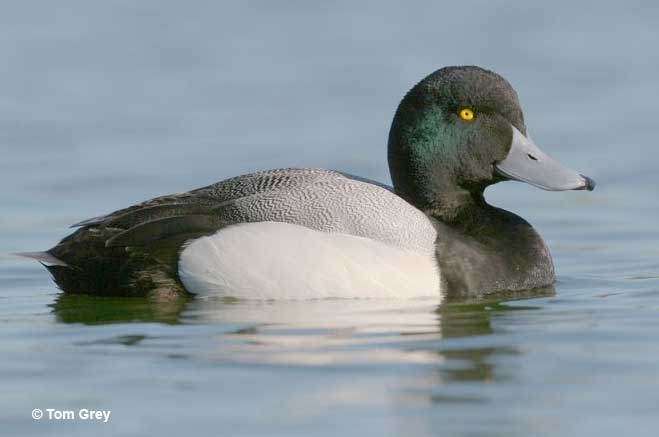
The Greater Scaup is very similar to the Lesser Scaup. Some birds can’t even be identified in the field! You need a really good look to separate them! Since their plumages look pretty much the same, for floating birds, you have to focus on the shape of the head and beak.
Lesser Scaups have a more “peaked” head with a slenderer beak that has a narrow black tip. Greater Scaups have a distinct, rounded head that often bulges out in the front, and they have a heftier beak with a broader black tip.
In flight, focus on the pattern in the wings. Greater Scaups have white that nearly reaches the wing tips while Lesser Scaups only have white on half of their wings.
Ring-necked Duck
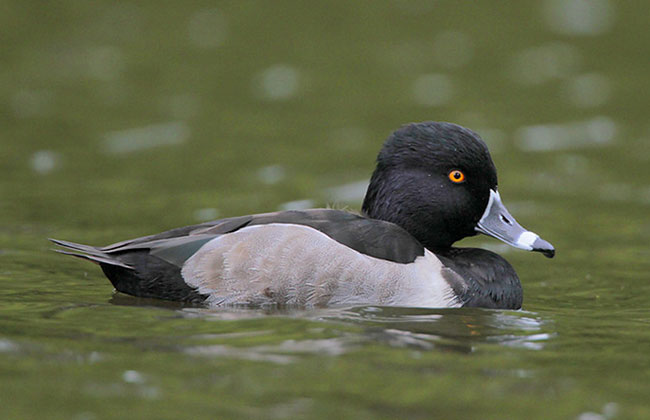
Photograph © Greg Lavaty
Ring-necked Duck is another duck species with similar plumage. However, they have a black back, a more black and white beak, and grayer sides. The female Ring-necked Duck also has a grayer face and a narrow white eyering.
Tufted Duck
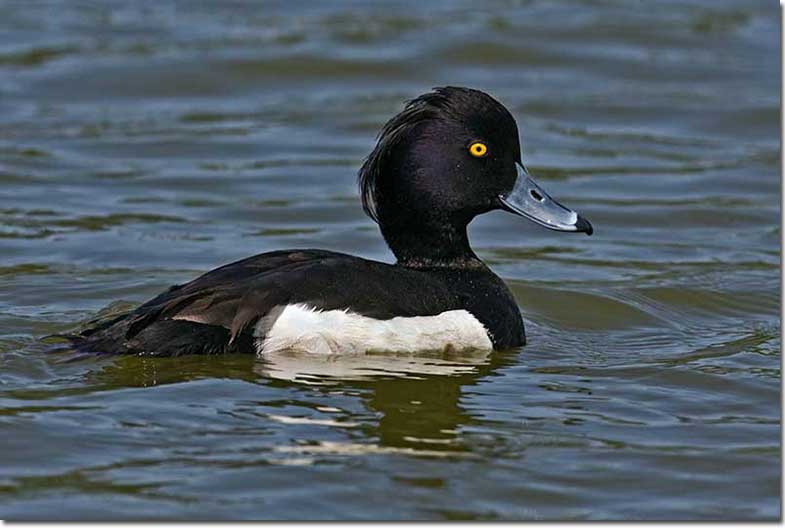
The Tufted Duck is a rare species in North America but can be seen with the Lesser Scaup. However, like the Ringed-necked Duck, it has a dark back, and also usually shows tufted feathers on its head.
Frequently Asked Questions
How rare is a Lesser Scaup?
A lesser Scaup is not rare. This duck is a common migrant and wintering bird on many lakes, shallow wetlands, and shallow bays.
Do Lesser Scaup eat fish?
No, Lesser Scaup do not eat fish. These ducks feed on aquatic insects, crustaceans, and mollusks.
What ducks are considered scaup?
Ducks considered to be scaup include the Lesser Scaup, Greater Scaup, and the New Zealand Scaup.

